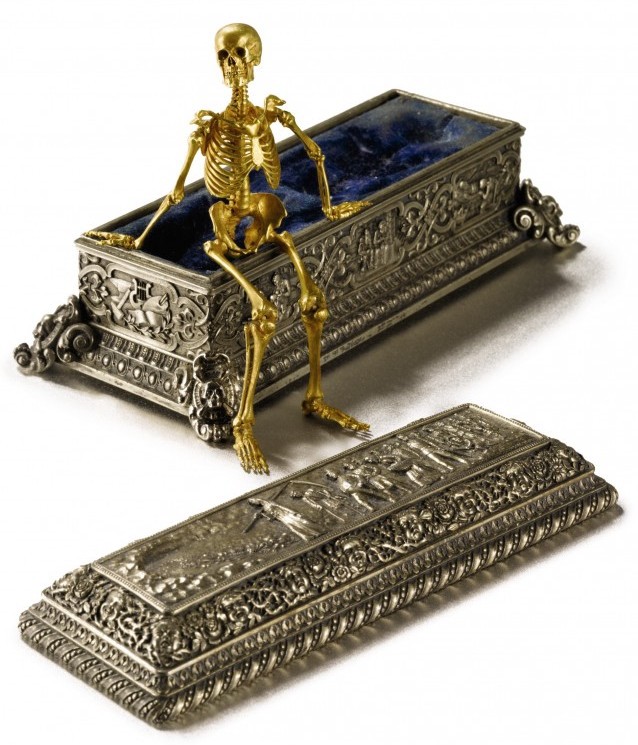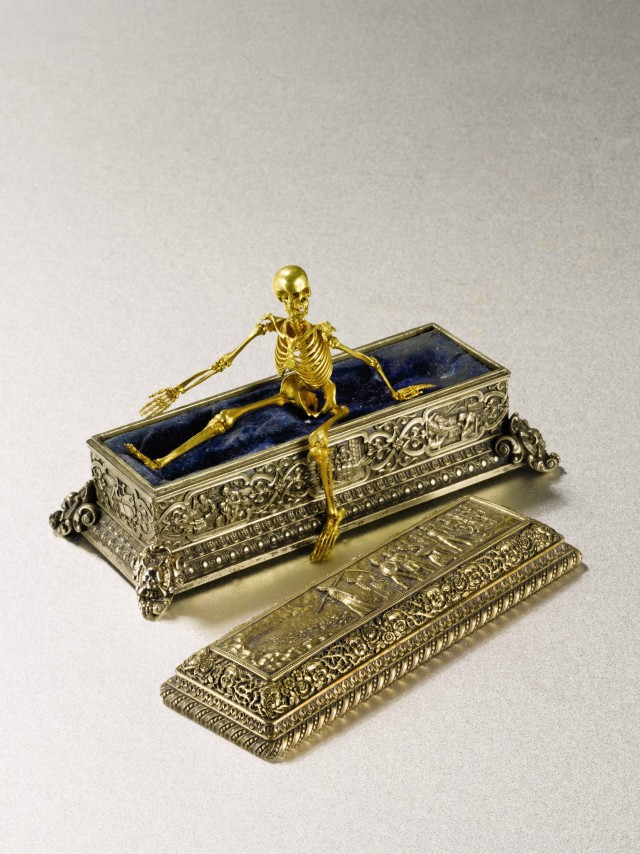So Many People Are Reading Fitzgerald Now That We Can Totally Afford To Look Down On Some Of Them
“I think it would bring shame to anyone who was trying to read that book on the subway.”
— In an age where people feel comfortable listing the TV shows they like on their resumes, are we really going to mock readers who carry around a copy of The Great Gatsby with a movie tie-in cover rather than the cover everyone knows from high school? Go ahead, laugh now, but in ten years when the only thing you ever see people reading is the novelization of “Angry Birds” or Fifty Shades of Grey for Kids you will look back at this era as the last moment of intellectual striving.
George Jones, 1931-2013
“Country Music Hall of Famer George Jones, a master of sad country ballads whose voice held the bracing power, the sweetness and the burn of an evening’s final pull from a bourbon bottle, has died after an illness that hospitalized him since April 18. He was 81, and was often called the greatest male vocalist in country music history.”
What's On Your Resume?
“When 21-year-old Stuart Goldberg went into a job interview last fall with a partner at the consulting firm McKinsey & Co., the University of Pennsylvania senior expected to discuss his 3.8 grade-point average, his internships in private equity or the data-crunching he’d done for the Philadelphia Eagles. Instead, the interviewer went straight for a different bullet point on Mr. Goldberg’s résumé: his interest in the cable-television series ‘Breaking Bad.’ They spent 10 of the interview’s 45 minutes discussing the dark drama about a high-school teacher who becomes a methamphetamine kingpin, Mr. Goldberg recalls. ‘I was shocked that he wanted to allocate so much time to that.’ The candidate was also pleased that his strategic decision to represent himself with a ‘popular yet relatively highbrow’ TV show had worked. He starts as a business analyst at McKinsey this summer, the consulting firm confirms.”
Carol Burnett Is 80
https://www.youtube.com/watch?v=c6v_gmaSTas
Carol Creighton Burnett, groundbreaking American comedy hero, turns 80 today. There are plenty of clips out there like this, and if you wanted to spend your day watching them who could blame you? The woman is a legend.
Senators Come Together To Fix Nation's Biggest Problem
‘I am so happy that we were able to work together across the aisle in a bipartisan way to solve this problem,’ said Senator Susan Collins, Republican of Maine, who helped spearhead the last-minute negotiations. ‘It’s nice to know when we work together we really can solve problems.’
— Gun violence? Meat safety? Childhood hunger? Guess what they came together to solve!
Scary New Machine-Worship Cult Arises: #NewDigitalAge
The #NewDigitalAge is a book about technology, but even more, it’s a book about humans. twitter.com/ericschmidt/st…
— Eric Schmidt (@ericschmidt) April 25, 2013
Google billionaire Eric Schmidt is the chief lobbyist for The Machines, and so he has produced a piece of propaganda to encourage humans to welcome the ever-expanding roles of programs in their lives. Borrowing its name from a lost Joy Division recording, #NewDigitalAge will help retrain what he calls “humans” to give up all their data to the algorithms of The Machines, in exchange for ease and entertainment.
Schmidt’s lobbying for The Machines includes teaching humans basic facts about The Machines and how wonderful they are. The Machines, in exchange, will continue to pay him handsomely, based on the number of humans who give up their data to The Machines.
There are no countries whose situations worsened with the arrival of the internet. #NewDigitalAge
— Eric Schmidt (@ericschmidt) April 17, 2013
Still America Then? Okay Good
“Travel in and of itself is not derogatory information.”
— That’s your chairman of the House Intelligence Committee, talking about why Tamerlan Tsarnaev didn’t get interviewed again after his trip to Russia. (He either was or was not one of the 745,000 people listed in the Terrorist Identities Datamart Environment.)
This Functional Yet Minuscule Gold Skeleton Can Be Yours On Monday

Hello, would you like to buy something weird? Hammer Time is our guide to things that are for sale in New York City… fantastic, consequential and freakishly grotesque archival treasures that appear in public for just a brief moment, most likely never to be seen again.
On April Fool’s Day in 1896, the Musée du Louvre issued an announcement: For 200,000 francs, they had acquired an ancient Greek tiara that once belonged to the Scythian King Saitapharnes. It was decorated with scenes from the Iliad and bore an inscription experts at the museum dated from late 3rd to early 2nd century B.C.E.
The Louvre proudly placed the Tiara of Saitaferne on exhibition, and scholars and connoisseurs travelled from all over the world to see the artifact. What began as a whisper in front of the display quickly turned into allegations echoing throughout the 1st arrondissement, and then far beyond. Leading archeologists declared it to be entirely bogus, a forgery crafted far from the Eurasian Steppes, and certainly long after the Iron Age.
The museum responded to aspersions cast about by experts with sharp reproach, but they nonetheless began quietly making house calls to preeminent craftsman. Eventually, a specialist’s attention turned to Israel Rouchomovsky, in Odessa.
Rouchomovsky showed the specialist around his small workshop, where he had completed a 3½ inch gold skeleton with 167 parts. It had taken five long years to create a fully articulated rendering, and he took particular delight in the lower jaw, which opened and shut. In Rouchomovsky’s memoirs, he wrote that he was truly satisfied as he made the final engraving, “Mozyr [18]92 Odessa [18]96” on the right splint-bone, and his name on the left, but “it was at that point that I realized that this ‘deceased’ deserved a beautiful sarcophagus.” He spent another five years on a velvet-lined silver coffin, illustrating the removable cover with the footsteps of the Angel of Death, surrounded by infants alternately laughing and crying. The base was contemplation on the course of life, with war at one end and the arts at the other.
Soon after, this visitor to Odessa made it known that he believed Rouchomovsky was “making antiquities,” a rumor the silversmith adamantly refuted in an 1897 letter to the Journal des Debats.
Years passed, but controversy of the tiara persisted. In 1903, a Frenchman came forward and announced the artifact was indeed a forgery, and he knew this to be true because he had made it with his own hands.
The admission reached Odessa, and left Rouchomovsky at an impasse. In 1894, the Hochman brothers had paid him 1,800 rubles, a little under 1,500 francs, to make a tiara. They provided him with articles about recent excavations, assuring him it was to be a gift for a discerning archeologist.
The shady antiquities dealers had deceived him and fleeced the Louvre, but he could not allow someone else to take credit for his painstaking work. Rouchomovsky wanted to put an end to the treachery that had ensued and so, at long last, he came forward.
By then, the Louvre had grown weary of such claims, and met Rouchomovsky’s confession with a challenge: Come to Paris and publicly replicate sections of the tiara. They offered to pay his fare, and Rouchomovsky realized that if he accepted the proposition, he could enter the skeleton and sarcophagus in the Salon Exhibition of Decorative Arts. He agreed, and satisfied their requirements shortly after arriving. The disgraced Louvre publicly apologized, and spoke of the silversmith’s master craftsmanship in superlative terms.
Rouchomovsky was instantly famous, and his skeleton and sarcophagus won gold at the 1903 Salon. French patrons, including Baron James de Rothschild, sent him back to Odessa with substantial commissions.
He planned to return to Paris, but the largest and most severe Odessa pogrom threatened his very existence. The communal violence against Jews, carried out with tacit approval from the authorities, dated back to 1821. During the 1905 pogrom, the army enabled mobs to attack with abandon. Police reported that at least 400 Jews and 100 non-Jews were killed, but the Jewish newspaper Voskhod placed the number at 800, and Governor Dmitiri Neidhardt estimated casualties to be around 2,500.
Rouchomovsky survived, and returned to Paris for the 1906 Salon with a greater sense of urgency. By 1910, he finally managed to move his family to Paris, where he remained until his death in 1934. In his final years, Rouchomovsky toiled over miniature tombstones for himself and his wife, which he engraved:
A happy man was I in life
Peace and quiet, bread and clothing were always found in my home
I loved my work, my wife, and my home
Even after my death my spirit will prevail
As the work of my hands that I have left behind
The last sentence of Rouchomovsky’s epitaph will once again ring true this Monday, April 29th, in Manhattan, when Sotheby’s will auction off the gold skeleton and the silver-gilt sarcophagus. The auction house estimates that the silversmith’s decade-long endeavor, which has resided in hedge fund manager Michael Steinhardt’s Judaica collection, will bring in $150–250,000.

Alexis Coe is now a writer living in San Francisco, but not long ago, she was a research curator at the New York Public Library. Her work has appeared in the Atlantic, Slate, The Millions, and other publications. Alexis holds an MA in history. Follow her. Image courtesy of Sotheby’s, who auction the Michael and Judy Steinhardt Judaica Collection in two sessions on Monday, beginning at 10 a.m.
New York City, April 24, 2013

★★★★ Cool but warm but cool. Morning clouds were smallish and somewhat numerous. The sky reflected in a turning dump truck’s chrome hubcap. The sign said there were six minutes till the next 1 train, which was enough of a reminder to stop short of the turnstiles and go back up the stairs and walk down Broadway instead. Noise rumbled up from deep in the pits for the water-main project in front of Lincoln Center. Men stood outside the Time Warner Center talking on their mobile phones, making hand gestures for emphasis. The B train was waiting at the foot of the stairs. Downtown, a pink-blossoming branch stuck out of a sidewalk trash can. The late afternoon clouds had become a sheet of gauze over the sky, smothering the daylight ahead of schedule.
